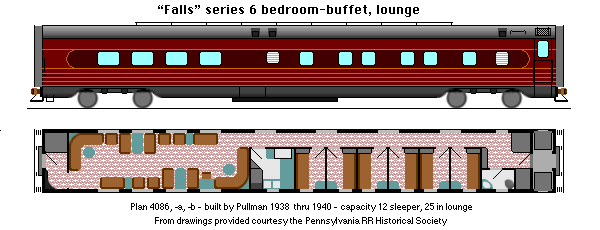
Content provided by Those Classic Trains

The mid-train lounge, non-existent in the Heavyweight era, is now essential to meet the demand for creature comforts on the premiere trains. In 1938, the Pennsylvania Railroad and the New York Central both ordered these cars from Pullman for their premiere trains, the "Broadway Limited" and the "20th Century Limited", respectively.
Following the new practice, these cars mix revenue sleeping space and non-revenue lounge space, thus providing at least some income. In this particular car, the 6 double bedrooms are the basic Pullman prewar design with the open toilets. However, Pullman has at least gotten rid of the paired small upper windows, which serve no purpose now that the berths are turned crosswise.
The lounge is a comfortable place with indirect lighting, attractive colors and piped-in radio programs (note the antenna on the roof). The seats are arranged in conversation groups and tables for card games. The buffet is a standard Pullman design serving drinks, sandwiches and snacks. A Steward is assigned, and doubles as Porter in the sleeping section.
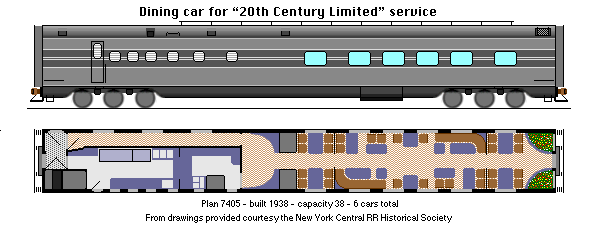
The modern dining car is represented by these six New York Central diners for the "20th Century Limited". The Century normally runs two sections. Two of these cars are assigned to each consist of the "20th Century Limited" and a single to the smaller "Advance 20th Century".
At left we see the traditional full kitchen, which has changed only in minor detail from the Heavyweight version. The oven still uses coal and ice is still loaded into the refrigerators through the roof hatches. One difference is that now the pantry ice boxes have their own roof hatches.
One peculiar feature at far left: the floor between the off-side service door and the kitchen door is corrugated safety tread steel plate: not something normally seen in passenger cars.
Note how the arrangement of the tables has changed. A first class diner today tries to avoid the"chow hall" look of the earlier row tables. Most of the seats can now be served from across the table and the open area in the center makes the movement of waiters and patrons easier. This car also serves as a mid-train lounge during off hours.
At right is a distinctive feature of these NYC diners. The dining room end has windows in it so that, when the two diners are coupled together, the patrons can look into the adjacent car. This is a peculiarity of the Century: when diners run in pairs, they normally run back to back with the kitchen ends coupled together - the opposite being done here. When these diners are running singly, the windows are covered with removable mirrors.
These windows are accented, in turn, by another tasteful innovation: a pair of semi-circular planters with silk flower arrangements.
Externally, we see that these cars roll on the unique 6 wheel triple-bolster trucks. These look like ordinary 6 wheel Pullman trucks at a glance, except for the individually mounted brake cylinders. The antenna on the roof provides radio programs for the dining lounge. The paint scheme is a New York Central adaptation of Pullman's prewar standard, which will be changed in the reequipping after the war.

These cars are typical of the prewar chair cars that are replacing the traditional coach in long distance travel. Several minor variations in seating numbers and arrangements have been built to this basic design for service on the joint UP - C&NW "Challenger".
This particular variant is a 52 seat chair car for women and families. Note that the ladies restroom is enormous compared to the men's restroom at the other end of the car.
The small single bedroom next to the ladies lounge is for the Registered Nurse. Registered Nurses have become a popular innovation on many roads. Coach trains traditionally do not have Porters, but the 2-3 RNs assigned to each train provide similar services in the women's cars as well as to the entire consist generally.
The individual reclining seats have foot rests and head rests. The seat pairs can be reversed and a drop table set in place, as shown next to the nurse's room.
The cars for "The Challenger" are jointly owned by the C&NW and the Union Pacific. In addition, the C&NW has similar cars of several types for their own use. An interesting note is that the C&NW cars are welded steel whereas the otherwise identical UP cars are riveted aluminum.
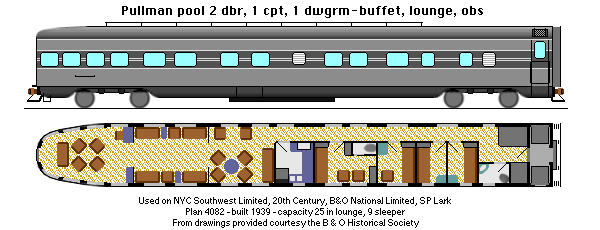
The big news in Lightweight equipment is the round end observation car, which takes the place of the traditional open platform and solarium Heavyweights. This particular design, with the long elliptical end, is called a "boat tail" obs.
Facilities in these cars are the very best and the decor is the most modern and tasteful. Typically, these cars will have some combination of compartments, single and double bedrooms, drawingrooms, and the new innovation: the Master Bedroom. Often, some of the bedrooms will be non-revenue - being assigned to the Conductor and the Pullman Representative.
In public facilities, there is a comfortable lounge with reclining chairs, sofas and card tables. Most cars feature a bar or buffet. One big feature of these cars is piped-in radio programs over the announcement speakers. A train line antenna is mounted on the roof and the radio handled by the Steward.
This particular car is about as close as the Lightweight Era has come to a general service pool observation car. A total of 7 of these cars were built. Three went to the New York Central, where they served on the "Southwest Limited". During World War 2, the Master Bedroom obs on the "20th Century Limited" were sidetracked and these put in their place. After the war, they went to the Baltimore & Ohio RR, who uses them on the "National Limited" to St. Louis.
Of the rest, 2 cars of plan 4082A went to the Southern Pacific's "Lark", where they were soon wreaked in separate rear-end collisions. 1 was built as an experiment to test new aluminum carbody construction techniques and 1 was built for the 1939 World's Fair. These two later entered pool service and ran on the "Arizona Limited" and in World's Fair service on the "Treasure Island Special". They were finally reassigned to replace the two wreaked "Lark" cars.
While a mere 7 cars is a tiny lot for the largest single Plan number, this carbody design has been standardized and dozens of observations built on it: the only differences being in the locations of windows (the window strip is engineered for variations) and in the interiors.
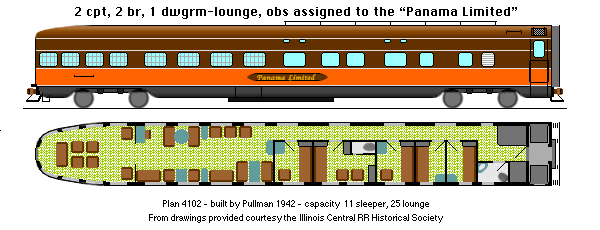
An example of what can be done with these carbodies are the two cars built for the Illinois Central's "Panama Limited". Being a simple variation on window spacing, these cars are among the most stylish and tastefully decorated of all. The decor is based on a New Orleans theme: with etched multi-pane lounge windows, floral print curtains, wrought iron grilles, hanging planters, and bright, cheerful tropical colors.
If any passenger wonders what awaits in the Crescent City, this idealized rendition of the French Quarter should reassure him!
These cars have a good selection of sleeping quarters, with a drawingroom, compartments and bedrooms. On some trains, the drawingroom in the obs is the deluxe accommodation of the train. This distinction is taken over by the Master Bedroom on the "20th Century Limited" and the "Crescent Limited". The Panama, however, has plenty of drawingroom space.
Further aft, the large French Quarter lounge has the usual array of card tables and plush seats, plus the rear observation area. The furnishings are an unusual rattan construction with upholstery which some describe as resembling Peacock plumes. Unlike most cars, these do not have a bar or buffet. However, the car Steward will bring you snacks and drinks from the lounge/sleeper which is next car forward.
Never shy about their Passenger Service, the IC gave the "Panama Limited" a remarkable pair of rear end markers. In place of the traditional drumhead in the rear door, the train name is spelled out in bright yellow neon script in streamlined shadowboxes bolted to the car sides.
Painted in the IC's newly adopted orange and chocolate scheme, these cars are the last of the pre-war boat tail obs: actually being delivered in early 1942 after the war started.
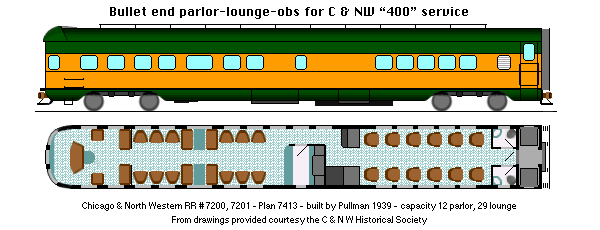
Our last offering is a parlor-lounge car for the "400". Round end parlor-obs are uncommon creatures, and this C&NW car is even more so because it has the blunt "bullet end" design more often found on Budd fluted side cars.
Accommodations include a bar-buffet, a central lounge with reclining chairs and table sections and the spacious round end observation lounge at the rear. Note, too, the extensive storage and equipment lockers in the center of the car. Up forward are 12 revenue parlor seats (they finally solved the problem of lining them up with the windows) and two small public restrooms. One thing notably absent is the traditional book case- although a 7 hour trip by Parlor would be an ideal time to catch up on your reading.
Another interesting feature is the dish shaped wind spoiler mounted over the rear of the car. One problem with any tail car is that the vacuum created by the train's passing sucks dirt and debris up and plasters them all over the rear of the car. Various experiments have tried to correct this problem by diverting a flow of air down the back of the car, thus breaking this vacuum. This particular concept was not repeated.
Chicago & North Western is one of the major operators of Parlor trains and has the most extensive Parlor service west of the Appalachians.
Note: refer to Free Downloads for reference sheets on Pullman car types.
| Home Site Map Search Contact |
North East Rails © Clint Chamberlin. |